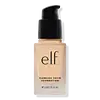What's inside
What's inside
 Key Ingredients
Key Ingredients

 Benefits
Benefits

 Concerns
Concerns

 Ingredients Side-by-side
Ingredients Side-by-side

Water
Skin ConditioningDimethicone
EmollientCyclopentasiloxane
EmollientGlycerin
HumectantIsododecane
EmollientPropylene Glycol
HumectantCetyl PEG/PPG-10/1 Dimethicone
EmulsifyingCyclohexasiloxane
EmollientC12-15 Alkyl Benzoate
AntimicrobialTridecyl Trimellitate
EmollientSorbitan Sesquioleate
EmulsifyingDimethicone/Vinyl Dimethicone Crosspolymer
Skin ConditioningBoron Nitride
AbsorbentPolymethyl Methacrylate
Magnesium Sulfate
Phenoxyethanol
PreservativeDisteardimonium Hectorite
StabilisingPEG/PPG-15/15 Dimethicone
EmulsifyingMagnesium Palmitate
Magnesium Stearate
Cosmetic ColorantSilica Dimethyl Silylate
EmollientEthylhexylglycerin
Skin ConditioningCaprylyl Glycol
EmollientParfum
MaskingSilica
AbrasiveTriethoxycaprylylsilane
CI 77891
Cosmetic ColorantIron Oxides
Water, Dimethicone, Cyclopentasiloxane, Glycerin, Isododecane, Propylene Glycol, Cetyl PEG/PPG-10/1 Dimethicone, Cyclohexasiloxane, C12-15 Alkyl Benzoate, Tridecyl Trimellitate, Sorbitan Sesquioleate, Dimethicone/Vinyl Dimethicone Crosspolymer, Boron Nitride, Polymethyl Methacrylate, Magnesium Sulfate, Phenoxyethanol, Disteardimonium Hectorite, PEG/PPG-15/15 Dimethicone, Magnesium Palmitate, Magnesium Stearate, Silica Dimethyl Silylate, Ethylhexylglycerin, Caprylyl Glycol, Parfum, Silica, Triethoxycaprylylsilane, CI 77891, Iron Oxides
Water
Skin ConditioningCyclopentasiloxane
EmollientEthylhexyl Stearate
EmollientIsododecane
EmollientDiisostearyl Malate
EmollientTrimethylsiloxysilicate
EmollientSilica
AbrasiveGlycerin
HumectantEthylhexyl Palmitate
EmollientLauryl PEG-10 Tris(Trimethylsiloxy)Silylethyl Dimethicone
EmulsifyingQuaternium-90 Bentonite
Bis-Isobutyl PEG/PPG-10/7/Dimethicone Copolymer
EmulsifyingSodium Chloride
MaskingPolysilicone-11
Phenoxyethanol
PreservativePropylene Carbonate
SolventTocopheryl Acetate
AntioxidantEthylhexylglycerin
Skin ConditioningPanthenol
Skin ConditioningCarthamus Tinctorius Seed Oil
MaskingMethicone
EmollientLecithin
EmollientPolyhydroxystearic Acid
EmulsifyingPanax Ginseng Root Extract
EmollientPentaerythrityl Tetra-Di-T-Butyl Hydroxyhydrocinnamate
AntioxidantIsopropyl Myristate
EmollientIsostearic Acid
CleansingPolyglyceryl-3 Polyricinoleate
EmulsifyingLaureth-12
EmulsifyingCI 77891
Cosmetic ColorantIron Oxides
Water, Cyclopentasiloxane, Ethylhexyl Stearate, Isododecane, Diisostearyl Malate, Trimethylsiloxysilicate, Silica, Glycerin, Ethylhexyl Palmitate, Lauryl PEG-10 Tris(Trimethylsiloxy)Silylethyl Dimethicone, Quaternium-90 Bentonite, Bis-Isobutyl PEG/PPG-10/7/Dimethicone Copolymer, Sodium Chloride, Polysilicone-11, Phenoxyethanol, Propylene Carbonate, Tocopheryl Acetate, Ethylhexylglycerin, Panthenol, Carthamus Tinctorius Seed Oil, Methicone, Lecithin, Polyhydroxystearic Acid, Panax Ginseng Root Extract, Pentaerythrityl Tetra-Di-T-Butyl Hydroxyhydrocinnamate, Isopropyl Myristate, Isostearic Acid, Polyglyceryl-3 Polyricinoleate, Laureth-12, CI 77891, Iron Oxides
Ingredients Explained
These ingredients are found in both products.
Ingredients higher up in an ingredient list are typically present in a larger amount.
Ci 77891 is a white pigment from Titanium dioxide. It is naturally found in minerals such as rutile and ilmenite.
It's main function is to add a white color to cosmetics. It can also be mixed with other colors to create different shades.
Ci 77891 is commonly found in sunscreens due to its ability to block UV rays.
Learn more about CI 77891Cyclopentasiloxane, or D5, is a silicone used to improve texture of products and trap moisture.
D5 is considered lightweight and volatile. Volatile means it evaporates quickly after application. Once evaporated, D5 leaves a thin barrier that helps keep skin hydrated.
It is also an emollient. Emollients help soften the skin and prevent water loss. Silicones create a silky texture in products. D5 helps other ingredients become more spreadable.
Studies show D5 is safe to use in skincare products. We recommend speaking with a skincare professional if you have concerns.
Learn more about CyclopentasiloxaneEthylhexylglycerin (we can't pronounce this either) is commonly used as a preservative and skin softener. It is derived from glyceryl.
You might see Ethylhexylglycerin often paired with other preservatives such as phenoxyethanol. Ethylhexylglycerin has been found to increase the effectiveness of these other preservatives.
Glycerin is already naturally found in your skin. It helps moisturize and protect your skin.
A study from 2016 found glycerin to be more effective as a humectant than AHAs and hyaluronic acid.
As a humectant, it helps the skin stay hydrated by pulling moisture to your skin. The low molecular weight of glycerin allows it to pull moisture into the deeper layers of your skin.
Hydrated skin improves your skin barrier; Your skin barrier helps protect against irritants and bacteria.
Glycerin has also been found to have antimicrobial and antiviral properties. Due to these properties, glycerin is often used in wound and burn treatments.
In cosmetics, glycerin is usually derived from plants such as soybean or palm. However, it can also be sourced from animals, such as tallow or animal fat.
This ingredient is organic, colorless, odorless, and non-toxic.
Glycerin is the name for this ingredient in American English. British English uses Glycerol/Glycerine.
Learn more about GlycerinIsododecane is a fragrance, emollient, and solvent.
As an emollient, it helps your skin stay soft and hydrated. Emollients help trap moisture into your skin.
Isododecane's role as a solvent makes it a great texture enhancer. It spreads smoothly on skin and does not leave a sticky feeling behind. Isododecane also helps prevent color transfer in makeup products.
Isododecane is not absorbed into skin.
Learn more about IsododecanePhenoxyethanol is a preservative that has germicide, antimicrobial, and aromatic properties. Studies show that phenoxyethanol can prevent microbial growth. By itself, it has a scent that is similar to that of a rose.
It's often used in formulations along with Caprylyl Glycol to preserve the shelf life of products.
Silica, also known as silicon dioxide, is a naturally occurring mineral. It is used as a fine, spherical, and porous powder in cosmetics.
Though it has exfoliant properties, the function of silica varies depending on the product.
The unique structure of silica enhances the spreadability and adds smoothness, making it a great texture enhancer.
It is also used as an active carrier, emulsifier, and mattifier due to its ability to absorb excess oil.
In some products, tiny microneedles called spicules are made from silica or hydrolyzed sponge. When you rub them in, they lightly polish away dead skin layers and enhance the penetration of active ingredients.
Learn more about SilicaWater. It's the most common cosmetic ingredient of all. You'll usually see it at the top of ingredient lists, meaning that it makes up the largest part of the product.
So why is it so popular? Water most often acts as a solvent - this means that it helps dissolve other ingredients into the formulation.
You'll also recognize water as that liquid we all need to stay alive. If you see this, drink a glass of water. Stay hydrated!
Learn more about WaterThis ingredient is a combination of red, black, and yellow iron oxide pigments. This combination of colors is usually found in foundation, because it results in a "skin" color.